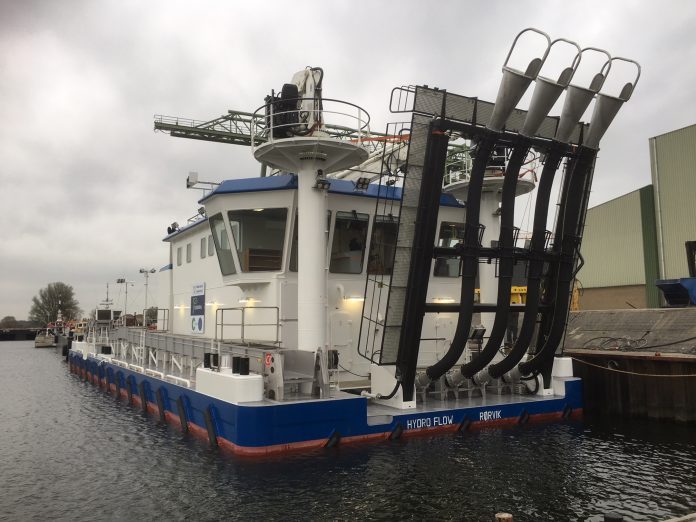“This is a new, upgraded version of our first hydrolicers, a move forward of our entry model. It’s eagerly awaited in Norway.”
Dutch shipbuilder Neptune Shipyard has built a pontoon with an integrated hydro-licer system onboard for Norwegian farmer, Bjørøya AS. The vessel was developed in close cooperation with Norwegian companies Hydrolicer and Bjørøya.
The pontoon was to be handed over to its owner last week, but due to bad North Sea weather, it’s still in Dordrecht waiting for a tow to Norway.
Alan MacFadyen, director at Hydrolicer Scotland, has been overseeing the building process of the Hydroflow for the past four months. While waiting for his flight back to Scotland, he talks to Salmon Business over the phone.
“I am closer to the Netherlands, so I have been functioning as an interface between Norway and The Netherlands,” McFadyen says.
It all happened in Aalst
The Hydroflow was completely assembled in Aalst, at one of Neptune Marines three shipyards.

“All the pipe work was delivered from Norway to the Netherlands. It was a heavy learning experience for Neptune, but they managed really well. We are very happy with their performance.”
Normally Hydrolicers are assembled in Norway, MacFadyen says. “This is the first one assembled in the Netherlands. With this, we have all gone through a huge learning experience.”
Improved components
The new model has several improved components. The main update is a new type of fish pump.“Before, we used a fish pump from the U.S., but with that we were struggled to handle the bigger fish. Sizes 5 to 7 kilos were too big. So my colleagues in Norway designed their own fish pump, without moving parts. It can handle 6 kilo average weight, so that’s a good increase.”
The initial barge was a custom-designed, all-purpose build centered around the new fish pump installation. “A lot of the machinery, and the underwater pumps, are inside now, which is easy for cleaning.”
Another improvement is the use of cold seawater. “It makes the delicing much more effective and lowers mortality, because it is very gentle and less stressy.”
Filtration system
The filtration system has also been upgraded. “After the lice have been washed off, you have to clean the transport water, while the fish are moved to the next pen. For this, we developed a filter consisting of two large, heavy-duty stainless steel drums. The new filter has a much better removal effect.”
The drum filter was also developed by Hydrolicer and built by a Norwegian engineering company. Interest is huge, says MacFaydyen. “Lots of companies from Scotland and Norway were eager to see the building process.”
Dutch involvement
The ‘Hydroflow’, one of the latest developments in delicing, is based on a modified pontoon design with the addition of hydrolicer equipment.
 Neptune is not the first Dutch company to build a pontoon with hydrolicer. Last year Maritiem Cluster Friesland en Nauplius Workboats built a similar barge for Marine Harvest Scotland. That consisted of a custom-built pontoon suitable for a large deck load of up to 3.5 tonnes per square meter.
Neptune is not the first Dutch company to build a pontoon with hydrolicer. Last year Maritiem Cluster Friesland en Nauplius Workboats built a similar barge for Marine Harvest Scotland. That consisted of a custom-built pontoon suitable for a large deck load of up to 3.5 tonnes per square meter.
Sustainable tool
The Hydrolicer was invented by Norwegians Frank Øren and founder Odd Einar Grøntvedt, and developed in cooperation with Cflow Fish Handling and Marine Harvest to fight salmon lice. The first prototype was tested for Marine Harvest Norway, Scotland and Faroe Island in 2015.
The Hydrolicer mechanically flushes water through closed columns called fish pumps. The fish ‘swim’ through the system and a jet of water rinses the lice off of the fish.
Hydrolicers can be retrofitted for existing vessels or ordered for new-builds.


